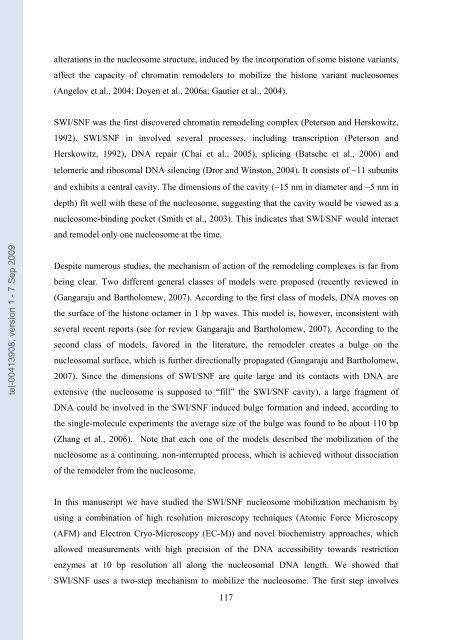Etudes sur le mécanisme de remodelage des nucléosomes par ...
Etudes sur le mécanisme de remodelage des nucléosomes par ...
Etudes sur le mécanisme de remodelage des nucléosomes par ...
You also want an ePaper? Increase the reach of your titles
YUMPU automatically turns print PDFs into web optimized ePapers that Google loves.
tel-00413908, version 1 - 7 Sep 2009<br />
alterations in the nuc<strong>le</strong>osome structure, induced by the incorporation of some histone variants,<br />
affect the capacity of chromatin remo<strong>de</strong><strong>le</strong>rs to mobilize the histone variant nuc<strong>le</strong>osomes<br />
(Angelov et al., 2004; Doyen et al., 2006a; Gautier et al., 2004).<br />
SWI/SNF was the first discovered chromatin remo<strong>de</strong>ling comp<strong>le</strong>x (Peterson and Herskowitz,<br />
1992). SWI/SNF in involved several processes, including transcription (Peterson and<br />
Herskowitz, 1992), DNA repair (Chai et al., 2005), splicing (Batsche et al., 2006) and<br />
telomeric and ribosomal DNA si<strong>le</strong>ncing (Dror and Winston, 2004). It consists of ∼11 subunits<br />
and exhibits a central cavity. The dimensions of the cavity (∼15 nm in diameter and ∼5 nm in<br />
<strong>de</strong>pth) fit well with these of the nuc<strong>le</strong>osome, suggesting that the cavity would be viewed as a<br />
nuc<strong>le</strong>osome-binding pocket (Smith et al., 2003). This indicates that SWI/SNF would interact<br />
and remo<strong>de</strong>l only one nuc<strong>le</strong>osome at the time.<br />
Despite numerous studies, the mechanism of action of the remo<strong>de</strong>ling comp<strong>le</strong>xes is far from<br />
being c<strong>le</strong>ar. Two different general classes of mo<strong>de</strong>ls were proposed (recently reviewed in<br />
(Gangaraju and Bartholomew, 2007). According to the first class of mo<strong>de</strong>ls, DNA moves on<br />
the <strong>sur</strong>face of the histone octamer in 1 bp waves. This mo<strong>de</strong>l is, however, inconsistent with<br />
several recent reports (see for review Gangaraju and Bartholomew, 2007). According to the<br />
second class of mo<strong>de</strong>ls, favored in the literature, the remo<strong>de</strong><strong>le</strong>r creates a bulge on the<br />
nuc<strong>le</strong>osomal <strong>sur</strong>face, which is further directionally propagated (Gangaraju and Bartholomew,<br />
2007). Since the dimensions of SWI/SNF are quite large and its contacts with DNA are<br />
extensive (the nuc<strong>le</strong>osome is supposed to “fill” the SWI/SNF cavity), a large fragment of<br />
DNA could be involved in the SWI/SNF induced bulge formation and in<strong>de</strong>ed, according to<br />
the sing<strong>le</strong>-mo<strong>le</strong>cu<strong>le</strong> experiments the average size of the bulge was found to be about 110 bp<br />
(Zhang et al., 2006). Note that each one of the mo<strong>de</strong>ls <strong>de</strong>scribed the mobilization of the<br />
nuc<strong>le</strong>osome as a continuing, non-interrupted process, which is achieved without dissociation<br />
of the remo<strong>de</strong><strong>le</strong>r from the nuc<strong>le</strong>osome.<br />
In this manuscript we have studied the SWI/SNF nuc<strong>le</strong>osome mobilization mechanism by<br />
using a combination of high resolution microscopy techniques (Atomic Force Microscopy<br />
(AFM) and E<strong>le</strong>ctron Cryo-Microscopy (EC-M)) and novel biochemistry approaches, which<br />
allowed mea<strong>sur</strong>ements with high precision of the DNA accessibility towards restriction<br />
enzymes at 10 bp resolution all along the nuc<strong>le</strong>osomal DNA <strong>le</strong>ngth. We showed that<br />
SWI/SNF uses a two-step mechanism to mobilize the nuc<strong>le</strong>osome. The first step involves<br />
117

















